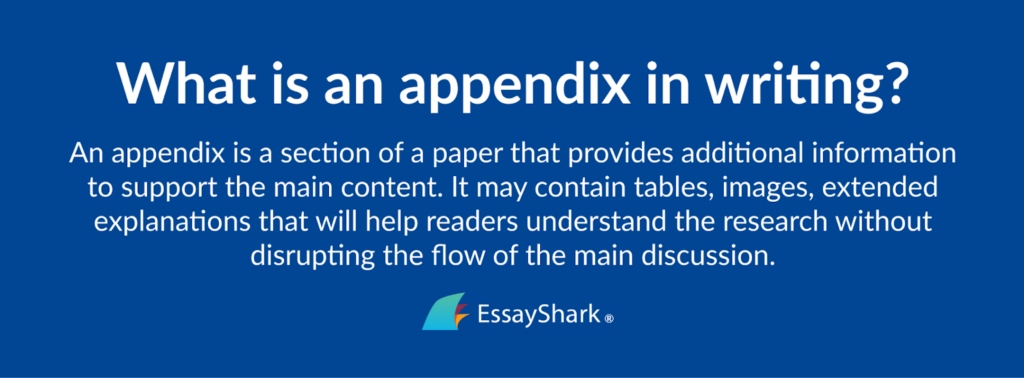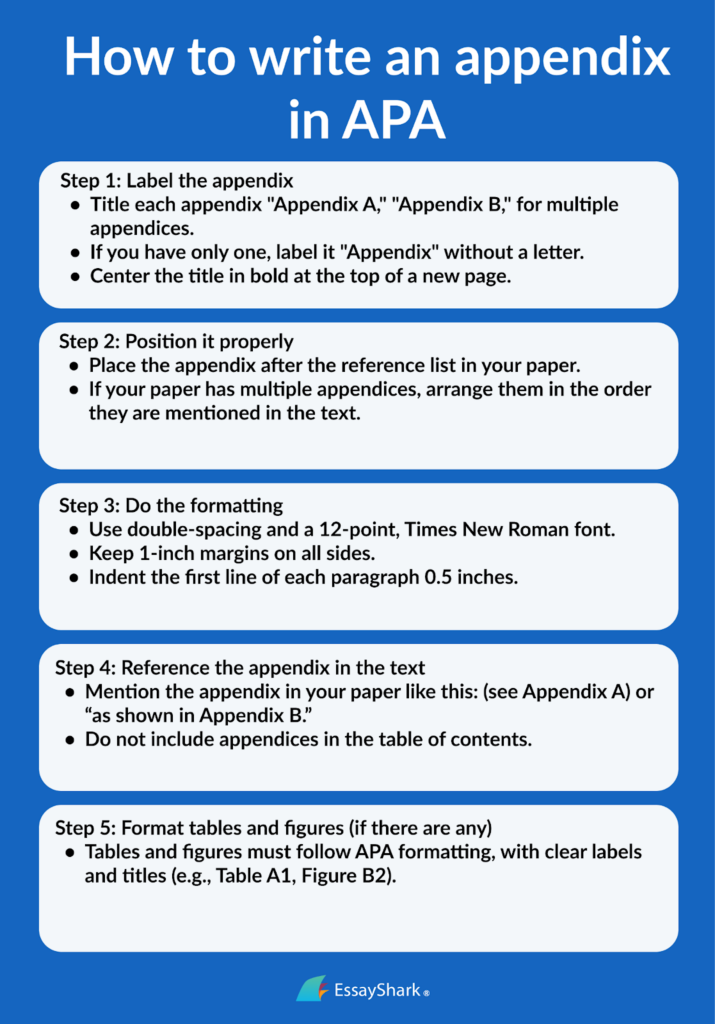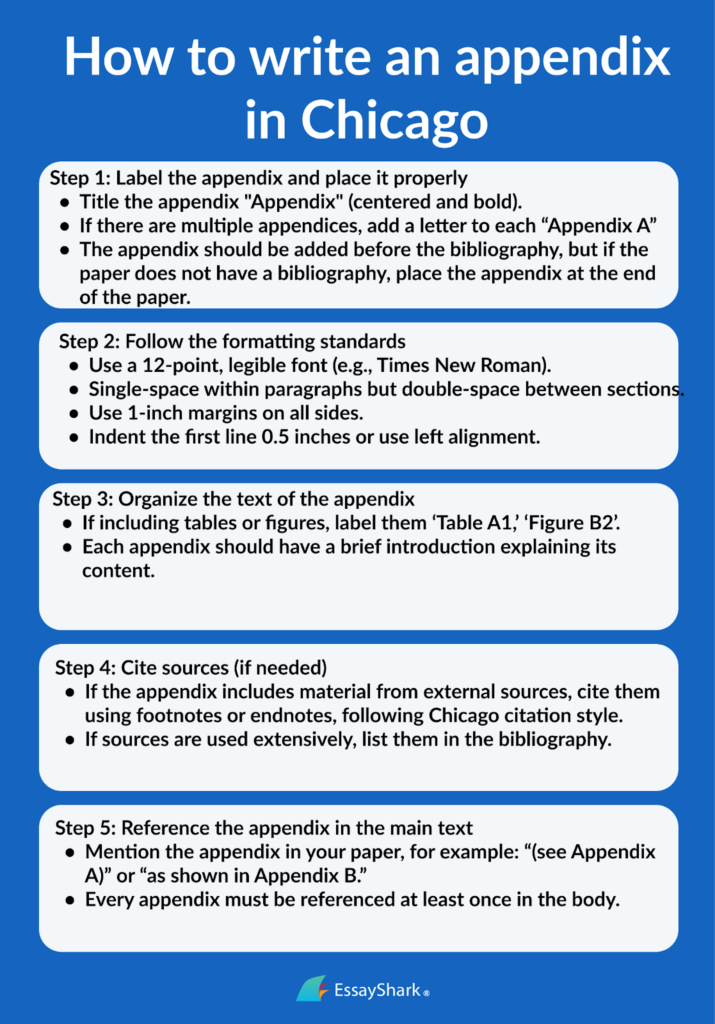If you are a college student, you are likely to seek information like how to write a poem analysis essay or how to quote a movie in an essay, depending on the type of assignment you get. Once you get a writing task, you may need to know how to write an appendix because this is a part of an academic paper that your professor may ask you to add to your writing assignment. What is an appendix in writing? How to craft a masterpiece? What does an appendix look like in a paper? The main goal of an appendix is to help you show the relevance of your research as well as its credibility.
In this guide, we will give you answers to the most frequently asked questions concerning appendix creation, tell you about its goals in different types of academic papers, and provide you with helpful tips on how to craft a professional appendix that meets your paper’s needs as well as academic requirements.
What Is an Appendix in Writing?
So, what is an appendix in a paper? In academic writing, an appendix is a section at the end of a paper that provides additional information that supports the main content of the paper. But, why should we add this information as an appendix? Well, we need this extra section because the original source of information may be too detailed or bulky, so we can’t include it in the body of the text without increasing the volume of the paper by several times.
An appendix may contain elements that are relevant for your writing such as raw data, survey questions, tables, images, or extended explanations that will help readers understand the research without disrupting the flow of the main discussion. We may need to add appendices to research papers, theses, and reports. These types of academic writing often require extensive supporting materials, which are not really essential for every reader.
The main goal of an appendix is to offer transparency and show the depth of your research, which will provide your readers with an opportunity to verify your findings or explore further details without overloading the primary sections. Of course, appendices have specific requirements you will need to follow in order to come up with a professional piece that meets your professor’s demands as well as academic standards. Your paper may contain several appendices, and each must be properly labeled. Moreover, you have to reference appendices properly in the main text and format them according to academic guidelines.

How to Write an Appendix in Different Formatting Styles
Of course, when you are assigned a college paper, you need to know how to write an appendix in different formatting styles so that you can meet your instructor’s requirements and make your writing look professional. The step-by-step guides below can help you easily compose strong appendices that meet academic standards to the fullest; choose the formatting style you need and follow the instructions.
How to write an appendix in APA
All the formatting styles have some steps in common, but there are also some specific points that make each style unique. First, we will take a look at how to write an appendix in APA style.
Step 1: Label the appendix
- Title each appendix “Appendix A,” “Appendix B,” etc. if you have multiple appendices, but if there is only one, label it “Appendix” without an additional letter.
- Center the title in bold at the top of a new page.
Step 2: Position it properly
- Place the appendix after the reference list in your paper.
- If your paper has multiple appendices, arrange them in the order they are mentioned in the text.
Step 3: Do the formatting
- Use double-spacing and 12-point, Times New Roman font.
- Keep 1-inch margins on all sides.
- Indent the first line of each paragraph 0.5 inches.
Step 4: Reference the appendix in the text
- Mention the appendix in your paper like this: (see Appendix A) or “as shown in Appendix B.”
- Do not include appendices in the table of contents.
Step 5: Format the tables and figures (if there are any)
- Tables and figures must follow APA formatting, with clear labels and titles (e.g., Table A1, Figure B2).

How to make an appendix in MLA
This quick guide can help you understand how to write an appendix in MLA. Take a look at all the essential steps and come up with a strong piece effortlessly.
Step 1: Label your appendix
- If you have only one appendix, label it “Appendix” at the top of a new page, but if you have multiple appendices, label them “Appendix A,” “Appendix B,” etc.
- Center the title in bold at the top of the page.
Step 2: Place it in your paper
- The appendix typically goes after the Works Cited page in a paper, but your professor may request a different placement, so you should follow their guidelines.
Step 3: Format it based on the guidelines
- Use double-spacing and a 12-point, legible font (e.g., Times New Roman).
- Set 1-inch margins on all sides.
- Indent the first line of each paragraph by 0.5 inches (same as the main text).
Step 4: Cite sources if necessary
- If your appendix includes outside sources, cite them properly within the appendix and in the Works Cited section.
- Use in-text citations following MLA guidelines.
Step 5: Refer to the appendix in your paper
- Mention the appendix in your main text, e.g., “(see Appendix A)” or “Refer to Appendix B for full survey responses.”
Appendix in Chicago formatting style
Finally, let’s take a look at the elements of Chicago appendix format. Follow these step-by-step instructions and rest assured that your appendix will be just perfect.
Step 1: Label the appendix
- As with other styles, if you have only one appendix, title it “Appendix” (centered and bold), and if there are multiple appendices, label them “Appendix A,” “Appendix B,” etc. in the order they are mentioned in the text.
Step 2: Position the appendix properly
- The appendix should be added before the bibliography (if it’s included), but if the paper does not have a bibliography, place the appendix at the end of the paper.
Step 3: Follow the formatting standards
- Use a 12-point, legible font (e.g., Times New Roman).
- Single-space within paragraphs but double-space between sections.
- Use 1-inch margins on all sides.
- Indent the first line 0.5 inches or use left alignment.
Step 4: Organize the text of the appendix
- When including tables or figures, label them ‘Table A1,’ ‘Figure B2’.
- Each appendix should have a brief introduction explaining its content.
Step 5: Cite sources (if needed)
- If the appendix includes material from external sources, cite them using footnotes or endnotes, following Chicago citation style.
- If sources are used extensively, list them in the bibliography.
Step 6: Reference the appendix in the main text
- Mention the appendix in your paper, for example: “(see Appendix A)” or “as shown in Appendix B.”
- Every appendix must be referenced at least once in the body.

What Is an Appendix in a Report?
Now that you know how to write an appendix in different formatting styles, let’s explore what roles appendices play in different paper types. So, what is an appendix in a report? This is a supplementary section that includes additional information that supports the main content but is not essential for understanding the primary findings or arguments. Using appendices, you will keep the main body of the report concise while still providing detailed background information for those who need it. Appendices are usually added to technical and business reports, where complex information such as data sets, charts, and legal documents may overwhelm the reader if included in the main text.
- Supplementary documents. These can be copies of official reports, policies, legal documents, or company records relevant to the validation of your report.
- Interview transcripts. Full responses from interviews can also be a part of the research.
- Technical diagrams. Include any flowcharts, blueprints, schematics, or detailed illustrations that explain the processes important for the report.
- Methodological details. These can be extended explanations of research methods, formulas, experimental procedures, etc. that provide deeper insight into the study’s approach.
With these elements, your report will remain focused and readable while still providing comprehensive information for those who require in-depth details.
Why Do We Need an Appendix in a Research Paper?
What is an appendix in writing for academic purposes? An appendix essay or an appendix in a research paper is a section that contains supplementary material that helps the reader understand the study but is not essential to the main text. With it, your research paper remains concise while providing supporting evidence and important background information. Researchers use appendices to present additional acknowledgement in research paper without disrupting the flow of the main argument.
- Statistical analysis. Large data sets, extended tables, or detailed statistical outputs that support the study’s findings but are too extensive for the main text.
- Figures, charts, graphs, etc. Visual representations of data that provide deeper insight but are not essential enough to include in the main discussion.
- Experimental procedures. Some additional explanations of research techniques, formulas, lab procedures, computational models, etc., that can help validate your study.
A well-organized appendix will give your report transparency, provide in-depth evidence, and allow readers to verify the research findings with ease. In complex studies where large datasets are necessary, this is a great solution for keeping the informational balance.
What Are the Goals of an Appendix in a Case Study?
Appendix writing in a case study is needed to support the analysis while keeping the main text light. It can contain additional data, documents, or explanations that will help your reader understand the main discussion.
- Internal company documents. You can add financial statements or policy documents that can support the case study’s analysis of a business or organization.
- Regulatory documents. These can be different court rulings, contracts, or government regulations relevant to the case. These can help to contextualize the legal or compliance issues discussed in your paper.
- Notes and field reports. For some readers, it can be helpful to take a look at detailed descriptions of the site visits, behaviors, or environmental factors you turned to during the research process.
- Supporting media. You may need to add photographs, maps, organizational charts, or screenshots that illustrate important aspects of the case.
Add a well-structured appendix to your case study to add credibility and transparency as well as provide deeper insights without overwhelming the reader.
What to Present in an Appendix in a Technical Paper
An appendix in a technical paper is a section that contains supplementary materials, technical details, or extensive data that support the main content but are not essential for the core discussion. It helps maintain clarity by keeping the main body of the paper concise while still providing in-depth resources for readers who need them. Appendices should be labeled sequentially (e.g., Appendix A, Appendix B) and referenced in the main text where necessary.
- Calculations. If you use any numerical data or computational models that support technical findings, add full pieces to the appendices to help those who need more detailed information get it effortlessly.
- Technical diagrams. These can include engineering blueprints, system architectures, or other visual representations that clarify the technical concepts presented in your paper.
- Algorithm descriptions. If needed, you can provide the full algorithms as well as programming scripts that were important for your study.
- Experimental setup. Ensure reproducibility, by adding in-depth descriptions of lab setups or testing environments.
- Industry standards. You can add copies of relevant technical standards, such as ISO, IEEE, ANSI, compliance documents, or safety protocols that you have consulted in the paper.
An appendix can help you come up with accurate, transparent, and readable information. Remember that the main discussion should remain focused while providing your audience with access to additional technical details for deeper analysis.
What Does an Appendix Look Like in a Paper for a Law Class?
An appendix in a document is a section that will include supplementary materials that support the legal argument or analysis presented in the main body of your document. Legal appendices are often used in briefs, memos, motions, and court filings.
- Legal documents. Provide your audience with the relevant contracts, statutes, case law, or regulations cited in the document.
- Court filings. Present previous court orders, pleadings, or motions relevant to the case under discussion.
- Transcripts. You can also add the full transcripts of any hearings used in the case.
- Legal precedents. These can include, for example, copies of relevant case law or legal opinions that support your arguments in the paper
- References to legal authorities. You may also need to add citations for legal journals, treatises, or other scholarly resources that are pretty large.
An appendix in legal writing ensures that readers, such as judges, attorneys, or clients, can verify the legal arguments and evidence without unnecessary distractions in the main body.
8 Reasons to Follow an Appendix Example to Learn in Practice
As with any other helping content, like PowerPoint presentation ideas or guides on how to change PowerPoint slide dimensions, having an appendix writing example in front of you can be really helpful if you have little to no experience with this type of writing: for example, if you are working with an appendix for the first time. So, this is what to pay close attention to when working with an example.
#1. See the structure
An appendix example will show you the proper way to organize information. You can see how to structure materials like data sets, charts, and additional documents clearly and separately from the main text. Moreover, by following an example, you can make sure your own appendix is formatted logically and is easy for readers to navigate.
#2. Save time and effort
Following a well-organized appendix sample, you can save a lot of time and effort because it will show you exactly how to format and structure your piece. This can help you avoid mistakes and ensure that you don’t miss any important details, such as correct labeling or appropriate references in the main text.
#3. See the best practices
Professional examples usually reflect the best practices for including supplementary material in an appendix, which you can effectively learn from. These practices can include things like clear and concise explanations to help you understand that the appendix in your own writing is referenced properly in the main text. Moreover, this is a great option for seeing if you have used the correct citations for your sources.
#4. Maintain consistency
When working on a large or complex document, maintaining consistency is essential. Following an appendix sample can improve the overall quality and professional appearance of your document.
#5. See how to provide clarity
You can browse a professionally written appendix sample to learn how to organize various types of supplementary information in a way that helps your readers understand the research without overwhelming the main argument. You should do everything possible to make your main text focused yet providing a clear, organized way for readers to access additional details upon their request.
#6. Omit errors
When you are following an appendix sample, you are less likely to make formatting or organizational mistakes in your own piece. Use the examples as a template for how to present complex data or documents in a way that adheres to standards and guidelines, and as a result, you will reduce the risk of omission or confusion.
#7. Stay confident in the final result
A strong example is your way of gaining confidence in your ability to properly include and format an appendix. Seeing a clear, well-organized example can reassure you that you’re following the correct procedure and prevent any doubts about whether you’re doing it the right way.
#8. Cite and reference properly
Well, when you ask how to make an appendix, you should know that appendices may contain data or documents that require proper citation and reference in the main text. When following an example, you can understand how to properly reference the appendix in the body of your writing assignment and rest assured that you will correctly guide your readers to the supplementary material.Save this guide on how to write an appendix to your bookmarks so that you can access it anytime you need to work on a paper that requires an appendix and make sure you have created a strong piece that meets all the academic standards and your professor’s demands. Moreover, you are welcome to use our free tools, like our essay word counter, if you need to know detailed information about your document, as well as our words to minutes calculator to understand how much time you will need to present your research. Finally, with the help of our GPA calculator, you can count your scores and assess your academic progress. So, if you need our help, don’t hesitate to come and get it!
Photo by Thalia Ruiz from Unsplash








